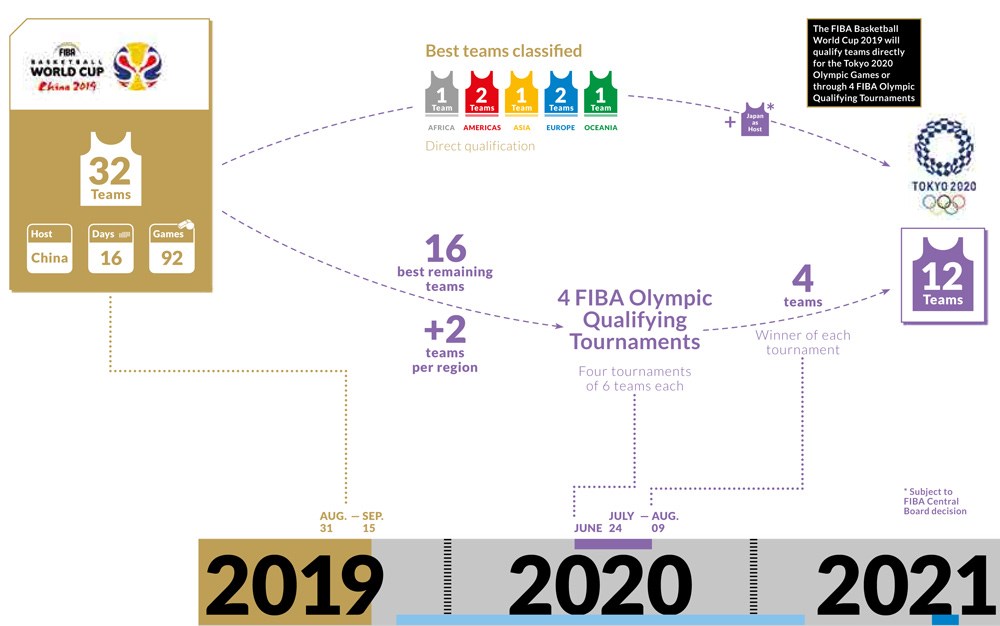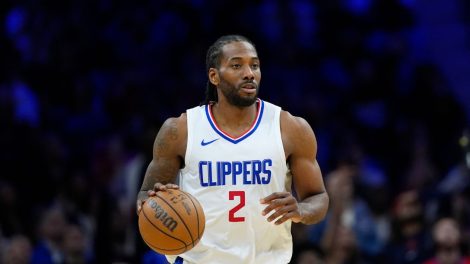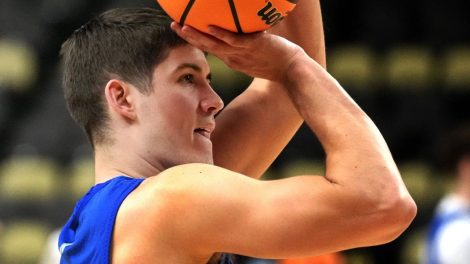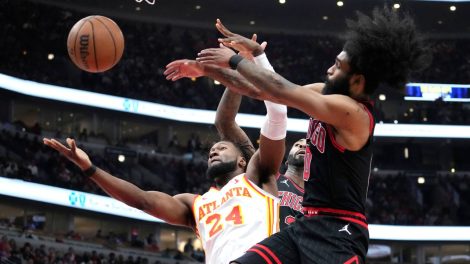With Canada Basketball unveiling its 29-man training-camp roster for the upcoming FIBA Basketball World Cup in China, it’s become that much more apparent just how close this key tournament is on the horizon.
Training camp begins in a little over two weeks. In case you haven’t been paying much attention to this point, here’s an FAQ to get you up to speed on the tournament itself, Canada’s projected roster and key dates to keep in mind.
[relatedlinks]
Key dates
Aug. 4-6: Training camp at OVO Athletic Centre
Aug. 7: Canada vs. Nigeria exhibition contest (7:00 p.m. ET, Mattamy Athletic Centre)
Aug. 9: Canada vs. Nigeria exhibition contest (8:00 p.m. ET, Bell MTS Place)
Aug. 16: Canada vs. Australia exhibition contest (5:30 a.m. ET, RAC Arena in Perth, Australia)
Aug. 17: Canada vs. Australia exhibition contest (5:30 a.m. ET, RAC Arena in Perth, Australia)
Aug. 20: Canada vs. New Zealand exhibition contest (5:30 a.m. ET, Quaycentre in Sydney, Australia)
Aug. 21: Canada vs. New Zealand exhibition contest (5:30 a.m. ET, Quaycentre in Sydney, Australia)
Aug. 26: Canada vs. USA exhibition contest (5:30 a.m. ET, Quodos Bank Arena in Sydney, Australia)
Aug. 31: 2019 FIBA Basketball World Cup kicks off with Angola vs. Serbia at 3:30 a.m. ET
Sept. 1: Canada vs. Australia World Cup contest (3:30 a.m. ET, Dongguan Basketball Center in Dongguan, China)
Sept. 3: Canada vs. Lithuania World Cup contest (7:30 a.m. ET, Dongguan Basketball Center in Dongguan, China)
Sept. 5: Canada vs. Senegal World Cup contest (3:30 a.m. ET, Dongguan Basketball Center in Dongguan, China)
What’s at stake?
Outside of the prestige of competing for a world championship, the World Cup offers the Canadian men’s team a chance to qualify for its first Olympic Games since 2000.
At the moment, only host nation Japan is assured a Tokyo 2020 tournament berth, leaving 11 remaining spots up for grabs. Of those 11, seven will determined based on results at this summer’s World Cup, while the remaining four will be determined in four separate last-chance qualification tournaments taking place between July 24 and Aug. 9, 2020.
The graphic below helps to break everything down:

In order to qualify for the Olympics via the World Cup, Canada needs to finish the tourney as one of the two best teams from the Americas region. And with the United States looking like it’s taking the tournament seriously, that means Canada will have to finish ahead of Argentina, Brazil, Dominican Republic, Puerto Rico and Venezuela.
However, that’s a task much easier said than done because of the potential road Canada will have to take.
What’s Canada’s roadmap looking like in the World Cup?
If Canada’s going to be one of the two best Americas-region teams in the tournament, its first obstacle will be getting through the initial group phase, an innocent-sounding affair that quickly becomes more akin to a Herculean Labour when you consider their company.
Group H
#AustraliaGotGame
#CanadaGotGame
#LietuvaGotGame
#SenegalGotGameTeam passes available now on https://t.co/4KG31hTOfk #FIBAWC pic.twitter.com/qEQgal1dbs
— Basketball World Cup (@FIBAWC) March 26, 2019
Take a look at that skull-and-crossbones emoji in the tweet above and consider what that means.
Yes, Canada drew the “Group of Death,” and as the No. 23–ranked FIBA nation will have to compete against No. 6 Lithuania, No. 11 Australia and No. 37 Senegal for one of the top two spots in the group to reach the second round.
But it doesn’t end there. For argument’s sake, let’s say Canada does make it through to the second round along with Lithuania. These two top teams from Group H would then move onto a second group phase that would see them placed into Group L, where they’ll see the top two teams from Group G.
Group G
#DominicanaGotGame
#FranceGotGame
#DeutschlandGotGame
#JordanGotGameTeam passes available now on https://t.co/4KG31hTOfk #FIBAWC pic.twitter.com/5PofIHT8Jw
— Basketball World Cup (@FIBAWC) March 26, 2019
Unless something truly bizarre happens, No. 3-ranked France and presumably either No. 18 Dominican Republic or No. 22 Germany will advance to Group L. That would put Canada in tough against two top-six basketball nations. And like in the first round, only the top two teams from there will advance to the quarter-finals.
And, of course, should Canada make it through both group stages to make it to the World Cup quarters, at that point it’ll just be an NCAA Tournament-style one-and-done toss-up where anything can happen.
In short, Canada’s facing a steep uphill climb for Olympic qualification out of the World Cup.
With all that said, it’s not like the team will be wanting for talent to try to get the job done, though.
Who’s on the roster?
Here’s the 29-man training-camp invite list for the World Cup:
| Player | Position | Hometown | Previous/Current Club |
|---|---|---|---|
| Nickeil Alexander-Walker | Guard | Toronto, ON | New Orleans Pelicans |
| R.J. Barrett | Guard | Mississauga, ON | New York Knicks |
| Aaron Best | Guard | Scarborough, ON | Riesen Ludwigsburg (Germany) |
| Khem Birch | Centre | Montreal, QC | Orlando Magic |
| Chris Boucher | Centre | Montreal, QC | Toronto Raptors |
| Oshae Brissett | Forward | Mississauga, ON | Syracuse Orange (NCAA) |
| Dillon Brooks | Forward | Mississauga, ON | Memphis Grizzlies |
| Brandon Clarke | Centre | Vancouver, BC | Memphis Grizzlies |
| Aaron Doornekamp | Forward | Napanee, ON | Valencia Basket (Spain) |
| Luguentz Dort | Guard | Montreal, QC | Oklahoma City Thunder |
| Shai Gilgeous-Alexander | Guard | Hamilton, ON | Oklahoma City Thunder |
| Melvin Ejim | Forward | Toronto, ON | BC UNICS (Russia) |
| Brady Heslip | Guard | Burlington, ON | Istanbul BBSK (Turkey) |
| Cory Joseph | Guard | Toronto, ON | Sacramento Kings |
| Mfiondu Kabengele | Forward | Burlington, ON | Los Angeles Clippers |
| Naz Mitrou-Long | Guard | Mississauga, ON | Salt Lake City Stars (G League) |
| Trey Lyles | Forward | Saskatoon, SK | San Antonio Spurs |
| Jamal Murray | Guard | Kitchener, ON | Denver Nuggets |
| Andrew Nembhard | Guard | Aurora, ON | Florida Gators (NCAA) |
| Kelly Olynyk | Forward | Kamloops, BC | Miami Heat |
| Kevin Pangos | Guard | Newmarket, ON | FC Barcelona Basketball (Spain) |
| Dwight Powell | Forward | Toronto, ON | Dallas Mavericks |
| Phil Scrubb | Guard | Richmond, BC | Zenit Saint Petersburg (Russia) |
| Thomas Scrubb | Forward | Richmond, BC | Openjobmetis Varese (Italy) |
| Marial Shayok | Forward | Ottawa, ON | Philadelphia 76ers |
| Andy Rautins | Guard | Syracuse, NY | Bahcesehir Koleji Istanbul (Turkey) |
| Nik Stauskas | Guard | Mississauga, ON | Cleveland Cavaliers |
| Tristan Thompson | Centre | Brampton, ON | Cleveland Cavaliers |
| Kyle Wiltjer | Forward | Portland, OR | Unicaja Malaga (Spain) |
While it may be disappointing that Andrew Wiggins isn’t on the list and that Tristan Thompson is reportedly skipping playing for Canada at the World Cup, there is still plenty of talent available for Team Canada head coach Nick Nurse.
Even without Thompson, the list still features 16 NBA players in addition to high-end NCAA players like Andrew Nembhard and top European-pro-league stars such as Kevin Pangos.
There’s a lot to like here and it’ll just be a matter of finding the right combination of 12 men to piece together over the next six weeks or so.
Nick Nurse is Team Canada’s coach — who would best fit his style?
From what we know of the playing style Nurse prefers, we can begin making educated guesses about what sort of personnel he will be targeting.
Position-less, versatile wings: Nurse favours length, quickness and athleticism at the two, three and four spots, mainly because on defence it allows his team to switch with impunity. Given the prevalence of the three-point shot (and the fact that the international three-point line is a little shorter than the NBA one), it’s important that you have a team that can stay with guys out on the perimeter.
And offensively, Nurse likes to see a lot of ball and body movement, so having wings that can slash, run the floor and get to the basket off the dribble is paramount.
Some prime candidates include: Melvin Ejim, R.J. Barrett, Dwight Powell, Mfiondu Kabengele and Dillon Brooks.
Shooters: This is the case for basically every basketball coach in the world, but Nurse really likes having shooters all over the floor – and at every position – to help stretch opposing defences.
Luckily for him, Canada has a number of players who can fill this role, from three-point shooting big men Kelly Olynyk and Chris Boucher to gunners Jamal Murray, Nickeil Alexander-Walker, Brady Heslip, Nik Stauskas and Kevin Pangos.
Rim protection: In addition to having versatile guys who can switch on the perimeter, another hallmark of Nurse’s defence is having at least one man back to act as a rim protector. As seen with Marc Gasol during the Raptors’ championship run, this role doesn’t necessarily need to be filled by a shot blocker. But it always helps to have one, and Canada features quite a few of them.
Khem Birch, Brandon Clarke, Boucher and Kabengele would all be great fits for this role. But keep in mind — because Nurse favours versatility, the big men on the eventual roster will also need to be able to cover the pick-and-roll, adding an extra wrinkle to what’s shaping up to be an intriguing centre battle.
Ball-handling and play-making: Lastly, it’s important for a Nurse-run offence to have at least one player on the floor who can be strong with the ball and make proper decisions with it.
You’d ideally like to have multiple guys like this, such as when the Raptors have both Kyle Lowry and Fred VanVleet on the floor in addition to Marc Gasol.
Chief among the available options here will be players such as Murray, Nembhard, Pangos, Cory Joseph and Shai Gilgeous-Alexander, and even a big man like Olynyk, who started his basketball career as a point guard before sprouting to the seven-footer he is today.
What would Canada’s ideal starting five look like?
Using what Nurse likes as a basis, this is what Canada’s ideal starting lineup would look like:
Point guard: Cory Joseph
Shooting guard: Jamal Murray
Small forward: Melvin Ejim
Power forward: Kelly Olynyk
Centre: Khem Birch
Are all of these players the absolute best Canada has available at their respective positions? With the exception of Jamal Murray, the answer to that question is: “Maybe?”
But while talent obviously matters, it’s crucially important to find the right balance between ability and experience.
With this starting five, you have a good mixture of national team stalwarts Joseph, Olynyk and Ejim, the undeniable skill of Murray, and probably the surest centre Canada has available to it in Birch.
This is where the withdrawal of Thompson hurts the most. With 19 senior men’s games under his belt, he’d likely have been one of the most experienced players for Canada at the World Cup. As such, he could’ve been a calming presence for some of the younger players who will be on this team.
Without Thompson, though, Birch’s shot-blocking and athleticism will come in handy for Canada.
As for the rest, in Joseph, Canada will have the reliable ball-handler and play-maker it needs to get into its offence as well as a guy who can shoot the three-ball. Murray is the star scorer who can cut, get his own shot off the dribble anywhere on the floor and make plays for others. Ejim is a versatile wing who can do a little bit of everything, and Olynyk is an advanced offensive big man who can run the floor and shoot threes.
What are the key rotation/positional battles to watch for in camp?
Finally, let’s take a quick glance at potential rotational battles of interest during camp:
Guards: As Canada is blessed with a lot of talented guards, there’s a lot of ways they could go with this. Do you focus on play-making at the expense of shooting, like you’ll get with Gilgeous-Alexander? What about shooting specialists that don’t bring much else such as Heslip and Stauskas? What about some of the kids with high upside like Barrett, Alexander-Walker and Nembhard?
It will be interesting to see what direction Nurse goes with his guard selection and rotation during the exhibition games.
Centres: Birch should be there with the team in China, but the others don’t have as simple a case to make, what with Clarke and Boucher never having suited up for any national team before.
It’ll be intriguing to see if Nurse even wants another traditional centre to come along with him on the team.
Small forward: Canada’s got a ton of guards and a healthy supply of bigs, but not much in between. As such, filling the three spot will be a bit trickier.
Even Ejim, who we have pegged as Canada’s starting swingman, is possibly better utilized as a small-ball four. It’ll be worth monitoring the lineups Nurse rolls with and who he has at the three because it seems like that’s the position that’ll determine how Canada will be playing on any given possession.








